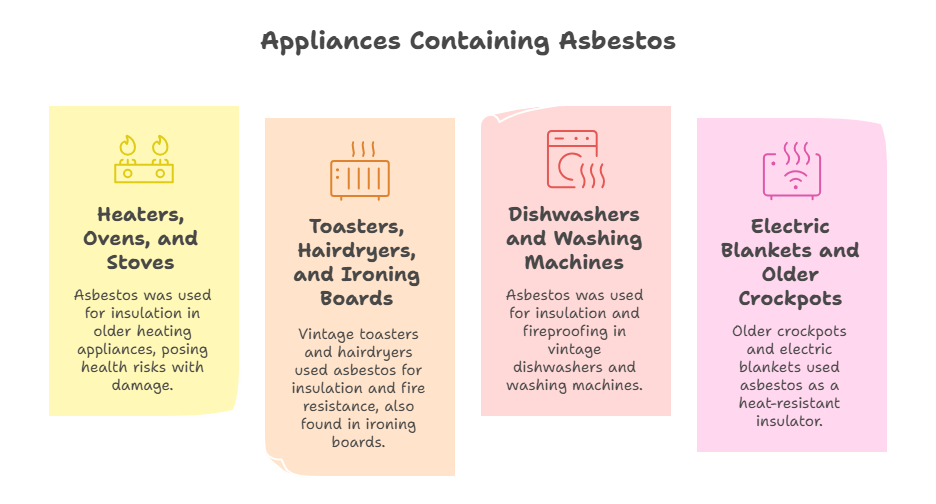The presence of asbestos is extremely common in older buildings. A study from 2024 revealed that 1 in 3 homes in Australia have asbestos in them. And if the house is built before the 1990s, then the risk is even higher.
When asbestos gets damaged, its fibres get scattered in the air, and that is exactly what starts a domino effect. Once you inhale it, it results in a series of health issues, sometimes even leading to death.
However, one big misconception about asbestos is that it is only found in roofs, walls, or insulation. While their presence in those places is true, they are also found in everyday household appliances. The presence of asbestos in ovens, furnaces, hair dryers, and other things is more common than one believes.
Well, a lack of understanding regarding this leads to one repeatedly using such articles in their daily life or buying second-hand appliances, which are another common place for asbestos. This is why this blog of ours will help you in understanding the risks of asbestos in heaters and older home appliances.
We will help you understand the hidden health dangers and what you can do if you suspect asbestos in iron and other appliances. This way, it will become easier to avoid the health risks and get the necessary solution for them.
Why Asbestos Was Used in Appliances
Once, asbestos was one of the most used materials in the world across different industries. From building materials and automotive components to daily use products like heaters or toasters, the presence of this toxic mineral was widespread.
Asbestos has heat-resistant and fireproof qualities, which is what makes asbestos a common material. On top of that, the material is highly durable and was considered one of the cheapest minerals for manufacturing. This is exactly what made Asbestos an affordable choice for manufacturers around the globe.
According to a study, the use of asbestos in Australia in different materials peaked in the 1970s. The same study suggested that the country also ranked the highest spot regarding per-capita asbestos consumption in comparison to all other countries.
During that time, the use of asbestos in heaters, ironing boards, or toasters became extremely common. This is why, when you shop for vintage appliances, the chances of asbestos being present in them become extremely high.
Common Appliances That May Contain Asbestos
Asbestos was once a popular building material, and its use spread across industries. The following are some of the common appliances that may contain asbestos.
Heaters, Ovens, and Stoves
The presence of asbestos in stoves or furnaces is very common. Portable and installed heaters, especially storage heaters and those in older furnaces and boilers, used to have asbestos insulation. However, repeated usage leads to damage to the asbestos, which increases health risks.
Toasters, Hairdryers, and Ironing Boards
Vintage toasters used asbestos for heat and electric insulation. In the same way, the mineral was used as a fire-resistant liner in hair dryers around the heating coils to insulate the heating element and prevent fire. Studies suggest that the material was used mainly in appliances from the 1980s to increase strength and fire resistance.
Lastly, the covers and the internal materials of old ironing boards were also used to contain the material, so the use of asbestos in ironing boards was very common.
Dishwashers and Washing Machines
Asbestos was used for insulation in the larger components of vintage dishwashers. Besides that, washing machines have asbestos as a gasket material and as fireproofing materials for components that generate heat.
Electric Blankets and Older Crockpots
Many of the older crockpots and slow cookers that were manufactured around the 1980s used to use asbestos as a heat-resistant insulator. The same goes for old electric blankets that used the same material for fireproofing and heat insulation.

How Asbestos in Appliances Poses a Risk
The presence of asbestos in hair dryers and other home appliances poses a series of health risks. When the asbestos-containing appliance gets damaged, repaired, dismantled, or disturbed in general, then it starts to release microscopic fibres into the air.
The moment someone inhales these asbestos fibres are then inhaled then it starts to irritate the body. Over time, asbestos causes scarring of the lungs, which is the root cause of a series of health issues.
Long-term asbestos exposure can lead to severe health issues like mesothelioma, and some studies suggest that the material is the primary cause behind such health conditions. Moreover, it also leads to various cancers like lung, laryngeal, and ovarian, and noncancerous conditions like asbestosis.
The risk is highest when asbestos-containing materials are damaged or improperly handled, making proper remediation and awareness crucial. This is why the presence of asbestos in stoves or ironing boards starts to create bigger issues.
Health Hazards Linked to Asbestos Exposure
Damaging the asbestos-containing materials releases small asbestos fibres into the air. This leads to health issues like:
Asbestosis
This is a chronic lung disease that is caused when one inhales asbestos fibres, and the material scars the lungs. Asbestosis takes at least a few years to appear after the first exposure, so its diagnosis is tough. However, some of the signs of asbestosis include shortness of breath.
Mesothelioma
This is a rare and aggressive cancer of the mesothelium, which is a thin tissue layer protecting internal organs. Mesothelioma starts by affecting the lining of the lungs but can also occur in the lining of the abdomen, or rarely, the heart or testicles. This is one of the work health hazards linked to asbestos exposure, and its symptoms vary by location.
However, most people experience chest pain, shortness of breath, and abdominal pain or swelling. But the worst part is symptoms start appearing decades after exposure, so timely diagnosis becomes tough.
Lung Cancer
The role of asbestos in lung cancer is huge; some studies even suggest that the material changes the DNA of the cells. Asbestos exposure causes lung cancer by leading to tissue damage, inflammation, and even scarring in the lungs. This, over time, triggers genetic, epigenetic, and cellular changes that result in malignancy.
Note: The risk of asbestos-related health hazards is higher for people who are regularly repairing or restoring old appliances. So, they need to take proper precautions or avoid such work completely.
Identifying and Handling Old Appliances Safely
Identifying the presence of asbestos in furnaces and other old appliances can be tough. However, if you have old appliances in your home, then you must act fast, ensuring you make no mistakes. The first thing that you must do is identify if the appliance was manufactured between 1970 and to 1990s.
Once identified, you should leave the appliance as it is and get assistance from experts in asbestos remediation. Even if the appliance is damaged and requires repair work, you should still avoid performing any DIY jobs.
Professionals must test the appliance/s and, on clarification, they will be the ones to dispose of them. Asbestos-containing appliances must be disposed of properly, and they should not be thrown out in the open, as the risk of contamination still persists.
On top of that, you must remember that using asbestos-containing materials is completely prohibited in Australia. On top of that country has a few restrictions regarding the disposal as well, which should be followed at all costs.
In Australia, handling asbestos-containing waste is regulated by state and territory legislation. The rules state that the waste must be wetted, double-bagged in 200um thick plastic, sealed, and labelled as “asbestos waste” before transport to licensed disposal sites.
What NOT to Do if You Suspect Asbestos
The presence of asbestos in daily-use appliances should be treated seriously and promptly. In case you suspect the presence of asbestos, then you must keep in mind the following things.
- Do not sand, cut, or dismantle the appliance.
- Avoid selling second-hand appliances without checking.
- Do not buy any second-hand or vintage appliance without much consideration.
- Do not attempt to “seal” or repair asbestos components.
- Get asbestos remediation services to tackle the situation.
Safer Alternatives for Homeowners
Here’s a simplified chart regarding the safer alternatives for asbestos-containing appliances.
| Appliance (Older Models) | Where Asbestos Was Used | Health Risk | Safe Modern Alternative |
|---|---|---|---|
| Toasters (pre-1980s) | Heat-resistant insulation and wiring | Release of fibres if damaged or dismantled | Modern stainless steel or ceramic-insulated toasters |
| Hair Dryers (1960s–70s) | Asbestos in heating elements | Direct inhalation risk during use | Modern hair dryers with ceramic or tourmaline heating |
| Ovens & Stoves | Asbestos pads, door gaskets, insulation | Exposure during repairs or wear | Contemporary ovens with fiberglass or ceramic insulation |
| Heaters & Radiators | Heat-resistant panels and insulation | Fiber release during deterioration | Electric or oil heaters with non-toxic insulating materials |
| Irons & Ironing Boards | Iron rests, pads, and insulation | Risk if the pads wear down or break | Steam irons and boards with cotton or felt pads |
| Refrigerators (Old Models) | Door gaskets and insulation | Asbestos dust exposure occurs when dismantling | Modern fridges use foam-based insulation |
| Coffee Pots / Kettles (Vintage Electric) | Asbestos cord insulation and heat shielding | Fiber release from frayed cords | Modern kettles with silicone-coated cords |
| Washing Machines & Dryers | Asbestos in brake linings, insulation | Risk during repair or disposal | Energy-efficient machines with synthetic insulation |
In Summation
Asbestos in stoves and other old home appliances is a hidden but real risk in older homes. However, these can even be used in second-hand or vintage appliances. This is why identification and careful handling are necessary. Otherwise, asbestos exposure can cause serious health hazards.
Once identification, one must move on to using other safer alternatives to such appliances.
Want to Identify Asbestos Presence in Your Home Appliances?
Get professional asbestos inspections and remediation from us. Protect your family from health hazards.
Frequently Asked Questions
Do Oven Mitts Also Get Asbestos-contaminated?
Yes, absolutely. If there was asbestos in the ovens, then there would also be asbestos in oven gloves. So, both should be disposed of.
What if I Experience Symptoms of Asbestos Exposure?
The only way to tackle any symptoms of asbestos-related health hazards is to get immediate assistance from a doctor. If diagnosed in time, one’s health can be improved.
Can Asbestos Be Cleaned From Appliances?
No, not at all. Asbestos cannot be cleaned or removed. So, the appliance containing the material should be completely disposed of.
Can Food Get Contaminated by Asbestos?
Yes, absolutely. If there is asbestos in toasters or ovens, then it will naturally contaminate the food. This is why it is essential to avoid using them.





